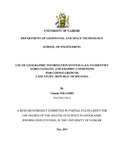| dc.description.abstract | The significance of geospatial technology to this project lies in the fact that agriculture is of spatial nature. Agriculture and natural resources are essentially understood by a geographic location. Spatial technology is an important lever in responding to changing market forces.
GIS is playing an increasing role in agriculture production throughout the world by helping farmers expand production, reduce costs, and manage their land more efficiently and effectively. Inconsistent practices such as coffee extension without matching the environmental conditions; and the issue of land space referring to the population size contradict the maximization of land use in Rwanda. The capability of GIS to visualize agricultural environments and workflows has proved to be very beneficial to the formulation of accurate strategies. The powerful analytical capabilities of the technology have been used to examine farm conditions, measure and monitor the impacts of environmental factors including the suitability of growing.
A thorough understanding of the potential and shortcomings about coffee growth in Rwanda has a positive significance for farmers especially those who are more interested in coffee crop investment, to clearly identify the better direction and actions.
In order to find out suitable conditions of coffee growing areas in Rwanda, my research was limited to the four most important agro-climatic and edaphic variables namely temperature, rainfall, elevation and soil ph distributed in the whole Country.
Therefore, the coffee growing areas in the republic of Rwanda was assessed through literature review, geospatial dataset such as administrative boundaries, environmental data, topographic and hydrologic data; then Strength, Weaknesses, Opportunities and Treats (SWOT) and Multi criteria decision (MCD) Analysis has been developed.
The results of the project have identified the favourate environment of Arabica Coffee in some areas of Rwanda; and therefore the policy should be established to encourage the right way of coffee plantation settlement and avoid the wrong practices cited above. | en_US |

